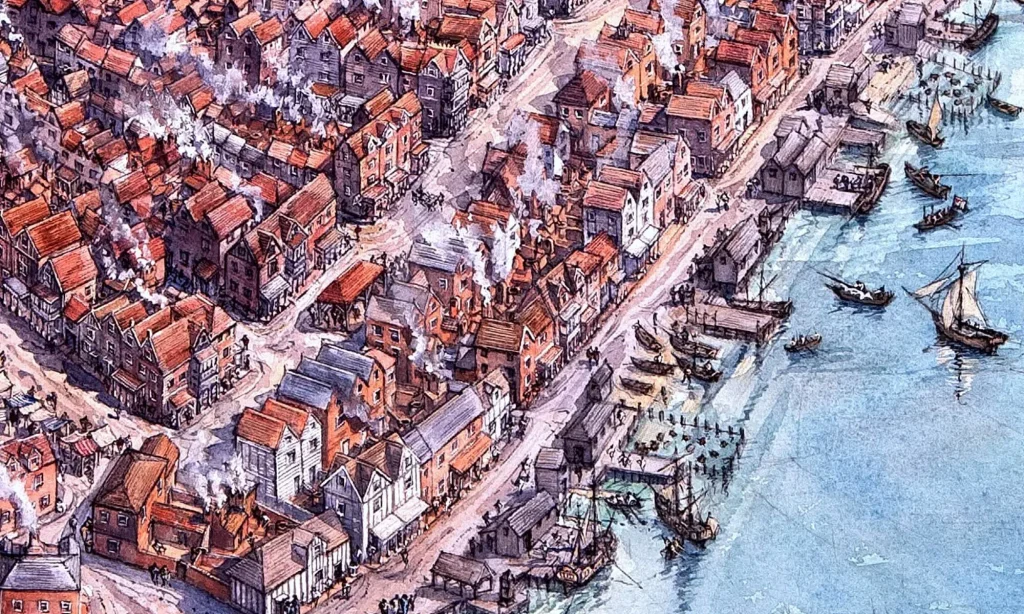Historical port towns have long served as crucial hubs of trade, culture, and maritime history, reflecting a rich tapestry of human endeavor. From the ancient wharves of Ipswich, steeped in centuries of Anglo-Saxon heritage, to the charming seaside allure of Ramsey, each town tells a unique story worthy of exploration. Lancaster’s maritime legacy reveals a darker past intertwined with slavery and commerce, offering a thought-provoking contrast to the idyllic landscapes of the medieval towns in the UK. These diverse locations not only connect us to pivotal moments in history but also provide off-the-beaten-path travel experiences for those seeking to walk where few tourists wander. Delve into the narratives of these port towns and uncover the layers of history that shaped our present.
Maritime municipalities, often known for their seaside vistas and bustling harbors, encapsulate historical significance that transcends time. Ports like Ipswich and Ramsey have evolved, showcasing remnants of medieval architecture while engaging with the transformative forces of trade and seafaring. Alongside, Lancaster’s stories echo through the streets, revealing connections to global trade networks and the complexities of societal evolution. These captivating coastal communities, rich in legacy, offer travelers a compelling glimpse into the past while encouraging a deeper understanding of their roles in shaping history. Embark on a journey through these remarkable maritime destinations and discover the cultural heritage waiting to be explored.
Exploring the Rich History of Ipswich’s Port Town
Ipswich, one of England’s oldest towns, boasts a captivating history that stretches back to the Anglo-Saxon era. The town’s historical significance is palpable, reflected in its medieval core, where the architecture reveals centuries of trade, commerce, and cultural exchange. The preservation of its historical wealth makes Ipswich a vital point of interest for those delving into the history of medieval towns in the UK. As you stroll through its quaint streets, you’ll uncover remnants of its Hanseatic past, with buildings like the Ancient House and St Mary-le-Tower standing testament to its rich maritime legacy.
This historical port town not only served as an export hub for wool and textiles but also formed vital trade routes with northern Europe since Saxon times. Through Ipswich’s journey to becoming a Hanseatic League member, locals engaged in international trade, thereby enhancing the cultural tapestry of the region. Visitors today can explore various historical sites that have survived the test of time, such as the Ipswich Maritime Trust, which remains active in preserving the town’s maritime history while promoting cultural heritage for future generations.
The Seaside Charm of Ramsey: A Hidden Gem
Ramsey, located on the Isle of Man, stands as a picturesque and historically rich port that offers a blend of natural beauty and intriguing past. The town’s name, derived from the Old Norse for ‘wild garlic river,’ reveals its Viking roots, indicating the importance of the sea for trade and community life. The charming seafront, along with a heritage electric railway, provides a scenic glimpse into the town’s maritime activities that shaped its historical identity. Historically, Ramsey served as a vital stopover for Steam Packet ships, facilitating travel and trade between the Isle of Man and the mainland.
In its heyday as a popular seaside resort, Ramsey attracted tourists and locals alike, drawn by its beautiful beaches and vibrant port activities. Today, the town’s blend of Victorian architecture and modern amenities offers a unique experience for visitors looking to explore off the beaten path. As you wander through its streets, you might stumble upon hidden treasures such as the Grove House museum, a testament to the town’s maritime heritage and the Gibb family’s influence on the local community.
Lancaster: A City Steeped in Maritime History
Lancaster’s history as a significant port town is marked by its complex relationship with trade and the darker aspects of maritime commerce, notably its role in the transatlantic slave trade. Once one of the largest slave ports in England, Lancaster was a hub for merchants engaged in the grim business of human trafficking. The city’s connection to slavery is evident through museums and historical sites that tell the story of those who suffered and those who profited from the trade. Today, Lancaster serves as a reminder of this turbulent past, raising awareness and providing educational insights into its historical legacy.
Despite its dark history, Lancaster is often overlooked by modern travelers seeking intriguing destinations. The city now promotes initiatives focused on reconciliation and remembrance, such as the revised slave trade and abolition trail, which enlightens visitors about the complex narratives intertwined within its maritime legacy. Explorers can look forward to visiting sites that highlight both the prosperity gained from the trade and the community’s progressive movements toward abolition, making Lancaster a significant stop for those interested in the historical nuances of UK maritime towns.
Ipswich: A Medieval Town Awash with History
Regularly overshadowed by larger cities, Ipswich offers an extensive narrative of life in the UK during the medieval period. The presence of thirteen medieval churches illustrates a religious and cultural landscape that was vital during the Anglo-Saxon era, with local lore and performances continuing to celebrate the town’s vibrant history. As visitors explore the narrow streets of Ipswich, they may find it hard to believe they’ve stepped into one of England’s best-preserved medieval towns, where historical sites reveal intriguing snapshots of bygone eras.
Ipswich’s transformation through its medieval legacy can be explored at local museums and memorials, where artifacts speak volumes about its bustling maritime trade and cultural significance. The town’s charm lies not only in its past but in its ability to keep history alive through various cultural events, local markets, and historical reenactments. This connection to its medieval roots serves as a draw for tourists interested in learning more about the UK’s rich historical fabric.
Ramsey: The Isle of Man’s Historical Port
Easily accessible yet often neglected by mainstream tourism, Ramsey offers an intriguing glimpse into the history of port towns in the UK. This charming seaside locale experienced significant growth during the Victorian era, partly due to its bustling port activities. Exploring Ramsey provides visitors with a fascinating juxtaposition of natural beauty and historic architecture, proving it’s a hidden gem within the Isle of Man, treasured for both its past and present.
As you admire the views of the harbor while walking along Queen’s Pier, you can’t help but ponder the stories of seafarers who once traversed these waters. The remnants of Ramsey’s era as a seaside resort tell tales of lavish lifestyles and trade that enriched the local economy. Today, as modern shops and eateries sit among Victorian buildings, the town maintains its essence, still echoing the maritime adventures that shaped it. Ramsey continues to be one of those off the beaten path travel destinations where the past is not forgotten.
Lancaster’s Maritime Heritage and Historical Significance
Lancaster’s historical pride is intertwined with its maritime legacy, where the River Lune and the Lancaster Canal played pivotal roles in trade and transport during the city’s booming years. The remnants of its maritime past can be found in various forms—from the architecture to the grim tales of its involvement in the slave trade, Lancaster teaches valuable lessons about economic growth at a moral cost. Beyond the sailboats and the scenic views lies a city rich in stories about resilience and renewal, marking it as an essential part of the historical discussion surrounding maritime towns in the UK.
Visitors to Lancaster can explore its maritime museum, which houses exhibits that highlight the city’s industry and its darker past. Engaging with local history through guided tours or educational programs, one can gain a nuanced understanding of the cultural and economic dynamics that influenced the community’s development. While Lancaster’s maritime identity comes with a complex narrative, acknowledging its full history fosters a deeper appreciation for the transformation of this quaint city into a modern educational hub.
Unveiling the Treasures of Ipswich’s Medieval Architecture
Exploring Ipswich’s medieval architecture truly feels like stepping back in time. Notably, buildings like the Ancient House and the opulent Town Hall serve as reminders of the town’s rich historical tapestry. These structures, steeped in stories of trade and commerce, illustrate Ipswich’s vibrant role in medieval England, particularly as a notable port town. As you meander through the streets, take time to appreciate the intricate details of these buildings that whisper tales of prosperity and cultural exchange.
Ipswich’s architectural heritage is not merely for aesthetic appreciation; it embodies the spirit of community and resilience. Local organizations work tirelessly to restore and maintain these historical gems, ensuring that visitors can vividly experience the town’s past while enjoying modern amenities. The beauty of exploring such historical port towns lies in their dual narrative—both a glimpse into the vibrant story of past trade and the lively pulse of contemporary life.
A Ramsom Getaway: Discovering the Isle of Man’s History
Weekend travelers seeking picturesque vistas and rich history should certainly consider Ramsey on the Isle of Man. Often called a gateway to the island’s historical sites, this port town reveals a storied past, from its Viking origins to its role in maritime trade. With easy access to scenic walks and local markets, Ramsey attracts visitors looking for a refreshing getaway off the beaten path. Each corner of the town has a story to tell, from the historic railway to the remnants of its grand Victorian hotels.
As you delve into the community’s past, be sure to visit the quaint museums and enjoy local storytelling events that uncover Ramsey’s charm. Its port has been the lifeblood of the town, historically linking it with other regions and fostering a sense of shared heritage. Today, Ramsey stands as a testament to resilience and evolution, inviting tourists and locals alike to rediscover its unique identity amidst the stunning landscapes of the Isle of Man.
Lancaster’s Dark Maritime Legacy: Reflections on History
For those interested in the complex intricacies of history, Lancaster offers a thoughtful exploration of its past, touching upon the darker chapters of the maritime industry. Once a significant player in the slave trade, the city is committed to confronting this legacy through education and acknowledgment of its effects on society. This often-forgotten narrative intertwines with the city’s evolution, making Lancaster a place of poignant reflection for visitors.
Engaging with Lancaster’s history prompts discussions about ethics, memory, and the continuous journey toward social justice. The Slave Trade and Abolition Trail provides an enlightening opportunity to traverse this complex history and witness memorials to those who suffered. By fostering understanding through historical recognition, Lancaster invites insight, growth, and a deeper appreciation for how history shapes our contemporary communities.
Frequently Asked Questions
What is the historical significance of Ipswich in relation to historical port towns?
Ipswich, one of the oldest recorded towns in England, has deep roots in maritime trade dating back to Saxon times. As a Hanseatic League port, it played a crucial role in exporting wool and woollen cloth, while also importing wine from Bordeaux. This historical port town features a well-preserved medieval core with numerous churches and buildings that reflect its rich maritime heritage.
How does Ramsey represent a unique historical port town experience in the Isle of Man?
Ramsey is characterized by its historical importance as a working port in the Isle of Man, where Vikings and Scots once landed. It features the remnants of its past, with Victorian architecture mixed with a lively seafront poised against the backdrop of the beautiful natural landscape. Its historical significance as a seaside resort and shipping hub is reflected in landmarks such as the Queen’s Pier and the Albert Tower.
What can visitors expect to learn about Lancaster’s maritime history in historical port towns?
Lancaster’s maritime legacy is dark yet significant, being one of England’s largest slave ports in the 18th century. Visitors can explore its history through key sites such as Lancaster Castle, which housed the Pendle Witches, and various historical locations connected to the slave trade. The city’s museums and memorials recount stories of local merchants profiting from slavery and the enduring impact of this legacy.
What are the best historical sites to visit in Ipswich related to its port town history?
Visitors to Ipswich can explore several historical sites tied to its maritime past, including the beautifully preserved medieval core, St Mary-le-Tower, the Ancient House, and Tooley’s Court almshouses. The Ipswich Maritime Trust organizes events and activities that highlight the town’s legacy as a former Hanseatic port, perfect for history enthusiasts.
How does Ramsey reflect the combination of historical significance and local culture as a port town?
Ramsey’s blend of historical maritime significance and vibrant local culture makes it an exceptional port town. The town features remnants of its past, like the working port and Victorian architecture, while also offering modern amenities and local charm, including pubs and shops that reflect its social life. This juxtaposition makes it a unique stop for those exploring historical port towns.
What events highlight Lancaster’s connections to maritime history as a port town?
Lancaster hosts various exhibitions and trails that commemorate its maritime history, focusing on both its involvement in the slave trade and abolition efforts. The Lancaster Slave Trade and Abolition Trail invites visitors to explore memorials, historical buildings, and the enduring social impact of this dark chapter, marking it as a crucial site for understanding the complexities of historical port towns.
What are some recommended activities in Ramsey to explore its historical port town features?
In Ramsey, visitors can enjoy activities that highlight its historical port town features, such as taking a walk along the Ramsey Nature Reserve beach, visiting Grove House Museum, and experiencing the scenic views from Albert Tower. A ride on the Manx Electric Railway offers a glimpse into the town’s connection with its maritime past.
What makes Lancaster’s role in the transatlantic slave trade significant in the context of historical port towns?
Lancaster’s historical relevance in the transatlantic slave trade is significant as it showcases the complicity of local merchants in enslaving thousands of individuals. This legacy is reflected in the city’s architecture, memorials, and museums, making Lancaster a vital historical port town for understanding the economic and social ramifications of the slave trade on the community and beyond.
| Port Town | Key Historical Points | Highlights & Attractions |
|---|---|---|
| Ipswich | Rich medieval history with names reflecting its past; significant maritime trading history; Henry VIII’s influence; home to 13 medieval churches; connection to the Hanseatic League. | Ipswich Maritime Trust, Tooley’s Court, Christchurch Mansion, and river cruise on Victor. |
| Ramsey, Isle of Man | Historical importance as a Viking settlement; scenic working port; an important tourist spot; and heritage electric railway. | Grove House museum, Albert Tower, Queen’s Pier, and local pubs. |
| Lancaster | Notorious as a former slave port; connection to the Pendle Witches’ trials; Roman fort history; significant in the slave trade; remnants of a dark maritime legacy. | Lancaster Castle, Ashton Memorial, Maritime Museum, and the Slave Trade and Abolition Trail. |
Summary
Historical port towns like Ipswich, Ramsey, and Lancaster offer a fascinating glimpse into a past rich with maritime trade, social upheaval, and cultural development. Each town is steeped in tales of medieval merchants, slave traders, and the legacy of rich historical events that have shaped their identities. From the medieval churches of Ipswich to the Viking roots of Ramsey and the dark history of Lancaster’s slave trade, these towns highlight the multifaceted nature of Britain’s coastal heritage. Exploring these towns is not only an educational journey but also a poignant reminder of the histories that underpin their present-day charm.



